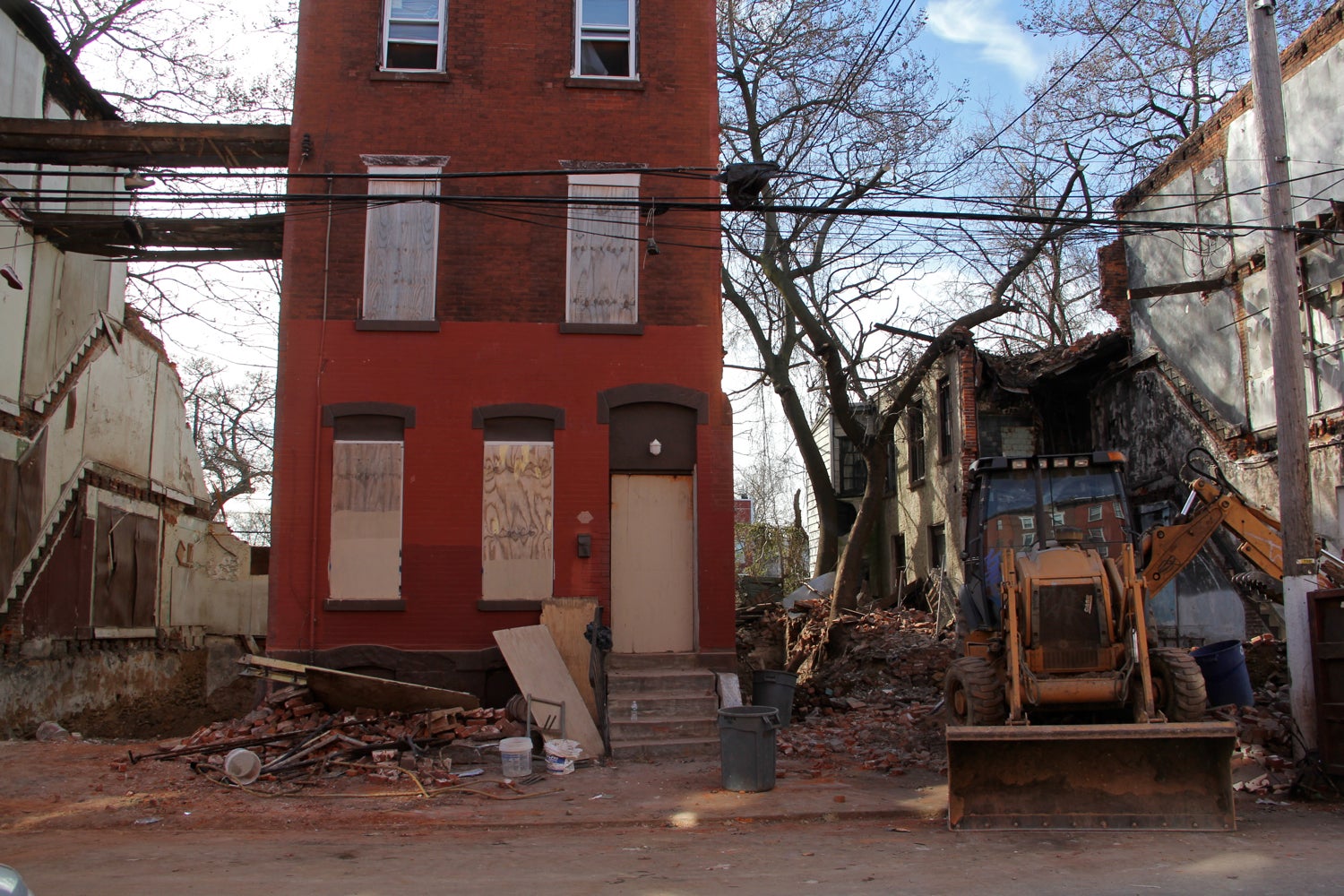In Philadelphia, a discussion about urban renewal and the ‘trauma’ of eminent domain

A home is demolished in the Sharswood section of North Philadelphia. (Emma Lee/WHYY)
During a panel at the Arden Theater, Philadelphia residents said there’s a lot they can relate to in August Wilson’s play, Two Trains Running.
Two Trains Running, a play by August Wilson that is about to finish a run at Philadelphia’s Arden Theater, takes place in the late 1960s, at a restaurant owned by a black man. The city is planning to seize the restuarant through eminent domain, and he fights to get what he considers a fair price. The characters talk about their struggles with racism, making ends meet, and a changing city.
Last night, during a panel discussion hosted by the theater and Keystone Crossroads, Philadelphia residents said there’s a lot about the play they can relate to.
The backdrop for Wilson’s play is urban renewal, a post-World War II policy of redeveloping distressed neighborhoods, often by seizing and condemning existing properties.
“Poverty and history have taught us that these sort of large-scale redevelopment projects don’t always work out,” said Rasheedah Phillips, managing attorney of the housing unit at Community Legal Services.
One example: in 1957, Philadelphia came up with an urban renewal plan for its Eastwick neighborhood, evicting more than 8,600 people and condemning thousands of acres of property. But the project went unfinished. Many of the promised homes were never built. A Philly.com article from last year describes the neighborhood as “a grid of streets that lead nowhere,” with piles of debris in place of houses.
At the discussion, a Philadelphia woman whose family was evicted from Eastwick described the neighborhood as diverse, happy, and peaceful. She asked why years later, the land is still not redeveloped. No one had an answer.
It’s hard to ignore the racial and income component of urban renewal projects. Panelists pointed out that the people displaced by eminent domain and urban renewal projects are often poor and black, and they rarely get the opportunity to return to their homes.
Indeed, the Philadelphia Redevelopment Authority “has made a reputation for pushing black folks out for white folks,” said Brian Abernathy, First Deputy Managing Director of Philadelphia and the former executive director of the Philadelphia Redevelopment Authority.
These projects have also fundamentally changed mixed-race, lower-income neighborhoods. Abernathy gave the example of a 1950s urban renewal project in Society Hill that many people now deem a success. “I’ve met lots of folks who were forced out and don’t necessarily agree,” he said.
The neighborhood, which was home to many working class black and Irish residents, is now predominantly white. It’s also the wealthiest in the city.
Present-day redevelopment projects
Much of the conversation at the Arden Theater focused on the Philadelphia Housing Authority’s $568 million, 10-year redevelopment plan to transform the Sharswood section of North Philadelphia into a “mixed-income community.”
To do that, PHA is seizing more than 1,300 lots through eminent domain. Only about 70 are occupied. The agency has also demolished two public housing towers, relocating the tenants to other parts of the city.
For some residents, especially older ones, being transplanted into a new community can be difficult. They can’t go to the same church or supermarket, and the friends they’ve made have been scattered far and wide.
The psychological toll can be particularly difficult for people who owned their homes, panelists said.
“Condemnation, at its very heart and soul, is traumatic,” said Abernathy. “The emotions wrapped up in property are very real. And the government has done a generally poor job in recognizing that trauma and the emotions.”
Abernathy, who added that he was speaking for himself and not on behalf of the city, called condemnation a “violent act,” saying that it’s basically ripping the soul out of a community.”
Some panelists said that in Sharswood, the neighborhood needs the help; its poverty and crime are double that of the city as a whole. But some of the blame, they said, rests on PHA, which allowed many of its own properties in Sharswood to sit vacant for decades.
Phillips said that although PHA didn’t sanction crime, the agency’s neglect of its own blighted properties “contributed in some sense to what’s going on in this community.”
“They need to take responsibility for that,” she said, “and this may be one of the ways in which they’re doing it.”
Earlier this year, PHA President and CEO Kelvin Jeremiah told PlanPhilly‘s Jared Brey that the redevelopment plan isn’t simply an attempt to fix the agency’s past mistakes. “I know that there are some who might believe that, but it’s not. It’s creating a better life for the families who have had to wait for something different and better for over 50 years. We’ve been telling them for the last 20 years we are going to confront these issues. We’re doing it in a meaningful way.”
He said the Sharswood plan is different from urban renewal projects of the past, because it’s also attempting to revitalize the neighborhood’s commercial corridor and reopen one of the schools.
WHYY is your source for fact-based, in-depth journalism and information. As a nonprofit organization, we rely on financial support from readers like you. Please give today.


